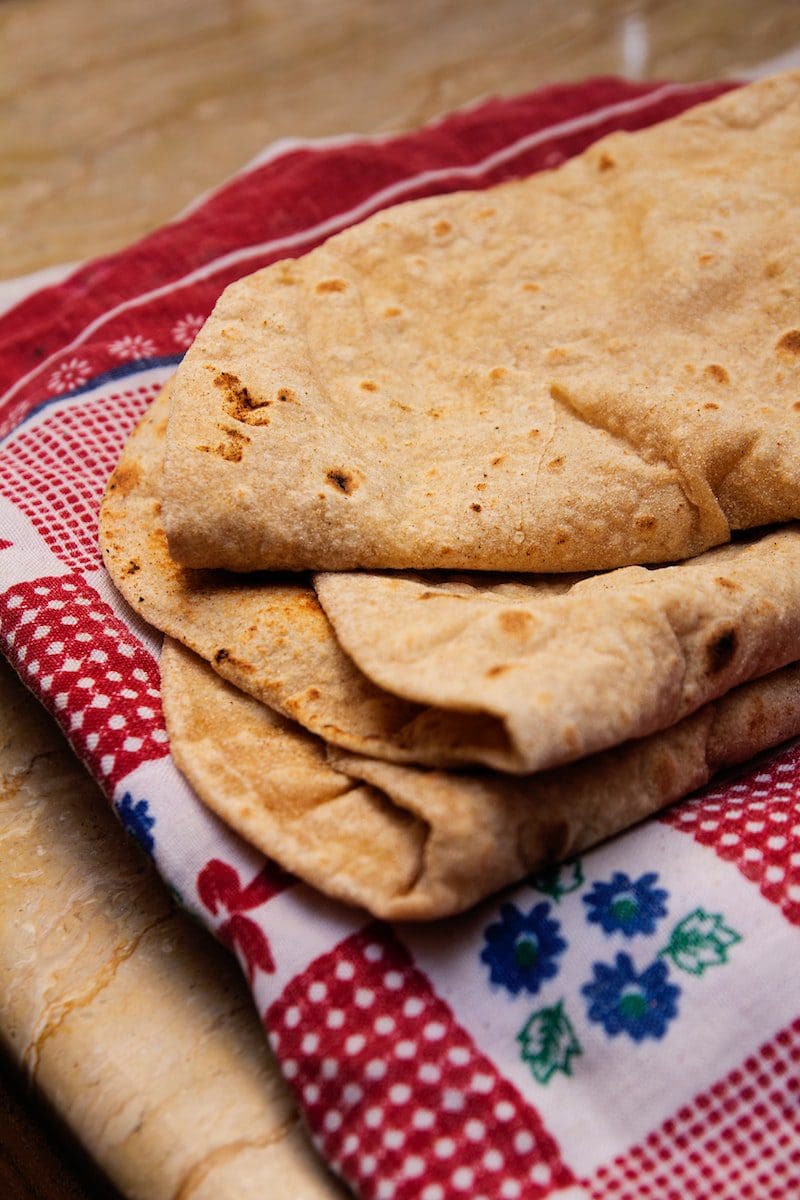Both naan and roti are different types of Indian flatbread. They are very different in many aspects, but both have many similarities.
Key Takeaways
- Naan is a leavened flatbread made with refined flour, yeast, and milk or yogurt, while roti is an unleavened flatbread made with whole wheat flour.
- Naan is cooked in a tandoor oven and is larger and thicker than roti, which is cooked on a grill or tawa and is thin and chewy.
- While roti is a staple food in many parts of India and South Asia, naan is considered more of a restaurant and is served with curries and other dishes.
Naan vs Roti
Naan is an oven-baked leavened flatbread made from all-purpose flour, yeast, and milk; it’s bigger and fluffier than roti. Roti is a griddle-cooked unleavened flatbread made with whole wheat flour and water; it is narrower and denser than naan.

Naan is a leavened bread made of Indian white flour; just like pastry flour, it is powdery and delicate. Naan is eaten with curry, and a spoon is used for picking up vegetables, meat, and sauce.
Naan is experienced with black seeds, which give a bit of astringent flavour. Rotis are flatbread food, which is very common in India.
This dish can be eaten with sauces or curries, or it can also be eaten with honey or wrapped around the food. Rotis are made in India as dinner or breakfast or sometimes as lunch.
Comparison Table
| Parameter of Comparison | Naan | Roti |
|---|---|---|
| Types | Naan has different types, like stuffed, buttered, and flavoured. | Phulka, tandoori roti and roomali roti. |
| Calories | Naan has high calories in it. | Roti has low calories in it. |
| Shapes | Naan can be made in different types of shapes. | Roti is always made in a circular shape. |
| Ingredient | Naan is made with refined flour. | Whole wheat flour is the main ingredient for making Roti. |
| Time-consuming | Naan is difficult to make, because of which it consumes time. | Roti is easy to make because of which it consumes less time. |
What is Naan?
Naan is an Indian dish with flatbread and a characteristic chewy texture, dense, almost the same as focaccia bread. Naan is served hot, and it can also be stored in the refrigerator to be used afterwards.
It is cooked in a tandoori oven so that it can be crispy. It is made from maida, a type of white flour in India.
Naan is seasoned with nigella seeds, which give an astringent flavour that is sometimes mistaken as black cumin or onion seeds. This dish has different flavours like butter, garlic, plain, and stuffed naan.
Naan can be made by taking two cups of maida or pastry flour; after that, one-fourth spoon of yeast should be added, half a cup of curd, water if required, and then press and mixture it into a soft dough. After doing that, it must be kept aside for two hours and covered with a lid.
After the dough, it should be divided into two. Taking one part thick like pizza bread has to be placed in a tandoor.
Remove it from the tandoor while cooking on both sides, and put butter on one side. It can also be stuffed with a different variation.

What is Roti?
Roti is also known as Chapatti. It is a famous flatbread in India. Roti is made up of stoneground wholemeal flour, also known as atta.
Rotis are eaten as a main course and are served with meat and vegetables. Roti also has different types, like tandoori roti and Roomali roti.
There are other types of roti called Phulka. Phulka is a type of roti that is half-cooked and then roasted.
Tandoori roti is also cooked in a tandoor and has a naan texture, whereas Roomali roti can be wrapped around kebab rolls. Roti can be made by slowly adding one cup of whole-grain wheat flour and adding water.
We have to mix it well and make a soft dough by adding water. After doing that, it has to be kept aside so that dough can take its form.
After that, we have to heat the Tava or skillet. To do that, we have to separate the dough into a four-part and roll it in a hand; then we have to flatter it so that it can be a form of translucent bread.
The last step is to put that in a Tava and cook on both sides until the brown dots appear. Then remove the Tava and put it directly on a flame. Cook both sides, and then your roti is ready.

Main Differences Between Naan and Roti
- Both naan and roti are famous Indian dishes which are eaten as the main course with meat and vegetables.
- Rotis can be eaten three times a day. On the other hand, naan can only be eaten in a single meal in the day.
- Rotis are very light and give nutrition to our bodies. On the other hand, naan is very heavy because it takes time to digest.
- Rotis are made with whole wheat flour. On the other hand, naan is made with refined flour.
- Rotis are very easy to make and take very little time. On the other hand, naan is difficult to make, and they are very time-consuming but also flaky and tastier.
- Roti can be made with plain flour. On the other hand, naan is made with leavened dough.




